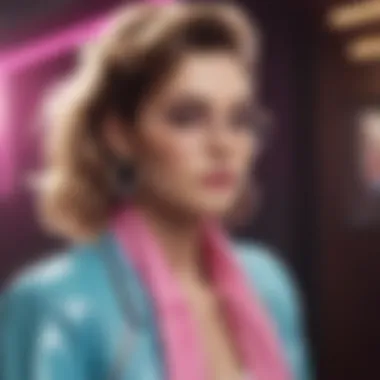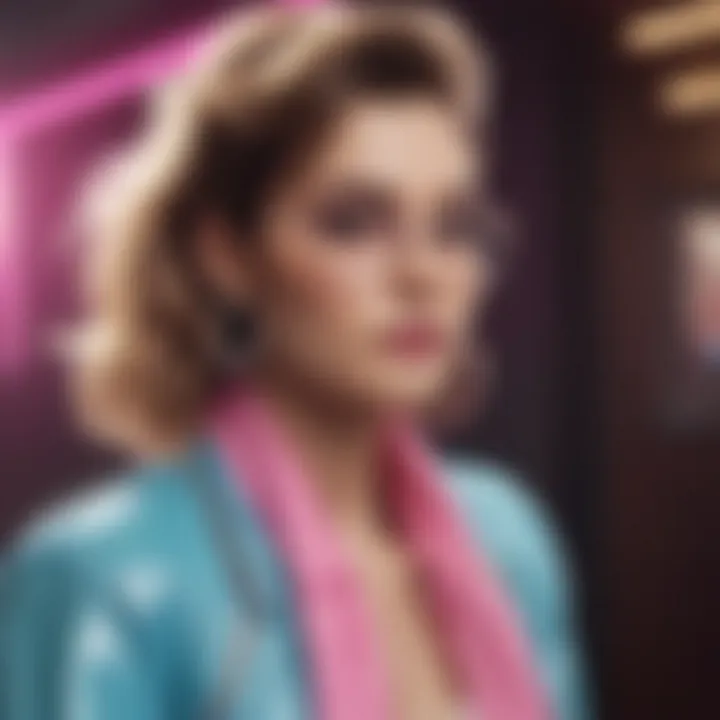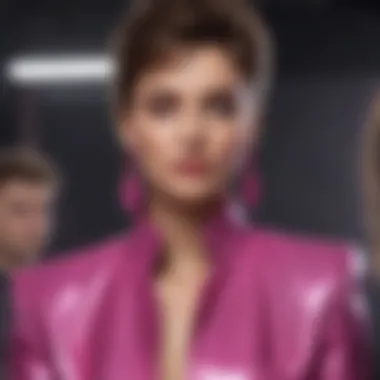Exploring 80s Inspired Fashion: A Journey Through Style


Intro
The vibrant colors, flamboyant styles, and bold expressions of the 1980s are making a thunderous comeback in today's fashion landscape. People are not just rummaging through their parents' old closets; they are embracing a rich tapestry of cultural influences that defined a generation. This journey into 80s inspired fashion invites women of all ages to rediscover styles that evoke freedom and creativity.
In this article, we'll take a close look at the key elements that characterized 80s fashion. From oversized silhouettes to neon hues, every detail tells a story—a story of rebellion, self-expression, and individuality. By exploring how these trends are mirrored in today’s wardrobes, we can appreciate how past styles continue to shape present aesthetics.
We'll reveal the seasonal trends that capture the spirit of the 80s, highlight the influences that set the tone for this iconic decade, and provide insights into how to adapt these styles for modern living. Moreover, it’s crucial to remember that style is not just about the clothes you wear; it's about how you wear them—your confidence is the real game-changer.
So, grab your shoulder pads and leg warmers, as we embark on this fascinating exploration of 80s inspired fashion!
The Cultural Significance of 80s Fashion
The fashion of the 1980s was more than just a set of trends; it was a vibrant reflection of the cultural and social dynamics of the time. The styles that emerged from this era were a product of various influences, serving as a mirror to society’s changing values, attitudes, and lifestyles. In this section, we will uncover the profound impact that 80s fashion had on personal expression and identity, highlighting its unique charm that continues to resonate with people today.
A Reflection of the Era
The 1980s can be described as a decade of bold proclamation. The fashion choices were loud—colorful, flamboyant, and unapologetic. This was a time when individuals sought to make grand statements carved from their identities. The vibrant colors of neon, coupled with oversized silhouettes, became symbolic of a generation that was not afraid to stand out. The era embraced the concept of individualism, where personal style became a vital component of self-expression.
The 80s taught us that fashion isn’t just about clothes; it’s a language through which we express who we are.
This cultural significance extended beyond just personal expression. The decade also bore witness to significant socio-political changes, and fashion became a tool for activism and solidarity. For example, groups advocating for social justice showcased their causes through unique styles, often using clothing as a canvas to speak for their beliefs. The trends popularized during this time weren’t merely fleeting whims; they often conveyed deeper meanings related to the spirit of the age.
Music and Movies Influencing Style
The symbiotic relationship between music, movies, and fashion in the 80s is undeniably noteworthy. Icons like Madonna and Michael Jackson didn’t just captivate with their melodies; their unique styles left an indelible mark on the fashion landscape. The music videos of the time often set the stage for new trends, from leather jackets to ankle boots.
Movies such as "The Breakfast Club" and "Flashdance" didn’t just entertain; they provided a window into youth culture, shaping style such that it became synonymous with the characters portrayed. For instance, the Fame era resulted in a surge of popularity in dance wear and athletic clothing, often worn as casual attire by various youth across different social strata.
The fusion of these cultural elements showed that fashion was not confined to runways but rather pulsated through everyday life. Clothing became a form of storytelling, functional yet expressive, signifying belonging or rebellion, depending on the context.
In summary, the cultural significance of 80s fashion is rooted deeply in its reflection of personal identity and societal shifts. The flair for expressive clothing informed by influential music and film permeated the decade, creating a titanic wave of style that continues to inspire today.
Signature Styles of the 80s
Signature styles of the 80s represent a vibrant era that combined innovative ideas with diverse influences. This section unpacks the visual language that defined a decade, characterized by everything from eclectic patterns to bold tastes, capturing the essence of individual expression during a transformative time. By understanding these signature styles, readers can appreciate how these trends not only shaped the fashion world then but continue to resonate in today’s wardrobes, providing insights into self-identity and cultural shifts.
Bright Colors and Bold Patterns
The 80s were a kaleidoscope of colors, with designers and wearers embracing vibrant hues in ways that had not been seen before. Gone were the muted tones of previous generations; instead, the streets pulsed with neon pinks, electric blues, and vibrant yellows. Think of the iconic visual language represented by artists like Prince and Madonna, whose wardrobes seemed to radiate from another planet.
Patterns accompanied this explosion of color. Bold geometric designs, abstract prints, and animal motifs paraded across fabrics—often mixed and matched in ways that boggle the mind today. A fabulous example is the well-known Hawaiian shirts, which morphed from vacation wear into a definitive part of casual living.
"Fashion in the 80s wasn’t about fitting in; it was about standing out, a vivid canvas of identity and self-expression."
Not only does this vibrant era echo in high fashion, but it seamlessly infiltrates modern casual wear. Streetwear today often revives bright patterns, adding a nostalgic yet refreshed twist to new collections—a true testament to the cyclical nature of style.
Oversized Silhouettes and Layering
If there’s one word that encapsulates 80s fashion, it would be oversized. Think of those massive sweaters, billowy blazers, and high-waisted trousers that seemed built for, well, an auto mechanic rather than a fashionista! This voluminous style was more than just a look; it was a statement against the fitted styles of the previous decades.
Layering played a vital role as well. The typical outfit often consisted of a baggy tee under a vivid blazer paired with parachute pants, and topped off with over-the-knee socks. This seemingly chaotic approach created visually dynamic outfits that flouted conventional rules. The influence can still be seen in today’s street style where fashion-forward individuals layer with abandon, mixing textures, lengths, and colors with ease.


In addition to creating an effortlessly chic vibe, oversized styles come with practical benefits. They offer comfort and versatility without compromising on style, allowing wearers to adapt their looks to various settings, from casual gatherings to upscale events.
Athletic Wear and Street Style
Athletic wear transitioned to street style with a gusto uncommon before the 80s. Tracksuits, scrunchies, and high-top sneakers not only provided comfort but became markers of cool. The likes of Puma and Nike brought performance wear into everyday outings, elevating the casual look to new heights.
This integration of the athletic aesthetic was partly fueled by a growing interest in fitness and pop culture—figures like Jane Fonda and the rise of aerobics classes brought gym wear into mainstream fashion. Combine this with the graffiti and punk movements alive on city streets, and you have a perfect storm for a stylish collision of influences.
These athletic wear pieces introduced a newfound relatability to fashionable looks; they were easy to find, comfortable, and suitable for multiple activities, hence why they have aged like fine wine. The ongoing prevalence of sneakers, leggings, and relaxed fit joggers in current fashion indicates a lasting impact that can’t be brushed aside.
Overall, signature styles of the 80s do not merely reside in the past; they continue to inspire how we think about fashion today. Reconciling comfort and aesthetic pleasure, these styles remind us of the freedom of expression that shapes our individual identities.
Key Wardrobe Essentials
The 1980s brought a slew of fashion styles that remain influential today. Understanding the key wardrobe essentials from this era is crucial for anyone looking to embrace or adapt these vibes in their own closets. Each piece tells a story, carries nostalgia, and offers versatility that can transform any outfit. The focus here is not just on the items themselves but also on what they represent—an era that thrived on self-expression and bold choices.
Denim Jackets and Acid-Wash Jeans
Denim jackets and acid-wash jeans were the quintessential staples of the 80s wardrobe. The raw, rugged quality of denim, especially in that unmistakable acid-wash look, symbolizes the rebellion of youth during this decade. Denim jackets could be found heavily adorned with band patches or painted designs, giving wearers a canvas to showcase their interests and personalities.
For women, pairing a fitted acid-wash jean with an oversized graphic tee created an effortlessly chic look that was both comfortable and style-conscious. These items transcended mere functionality—they represented a lifestyle of comfort, freedom, and creativity.
"Fashion is not just about clothing; it’s a form of self-expression that reflects the cultural heartbeat of the time."
- Versatility: Wear a denim jacket over a summer dress or layer it with a hoodie for winter.
- Elevating Outfits: Acid-wash jeans can be dressed up with heels or kept casual with sneakers, making them suitable for a range of settings.
Leg Warmers and High-Top Sneakers
Reflecting the dance culture of the 80s, leg warmers and high-top sneakers became styles often seen on the streets and in studios alike. They embodied the vibrant, energetic spirit that was all about moving freely whether it was at the gym or on the dance floor.
Leg warmers, often worn over leggings or paired with shorts, allowed for a playful take on layering. They provided warmth and a splash of color, perfect for making a statement. High-top sneakers, with their padded support and bold designs, offered a solid base for all the activity. These two essentials highlight not just the fashion, but the lifestyle tied to fitness and dance.
- Eye-Catching Colors: Both leg warmers and high-tops often featured neon shades that could brighten any outfit.
- Cultural Significance: They symbolize more than fashion—they are tied closely to the aerobics craze and the rise of street-style influences in mainstream fashion.
Padded Shoulders and Power Suits
Padded shoulders and power suits encapsulate the bold ambition and drive of the 80s, especially for women stepping into the corporate world. The shoulder pads created a silhouette that embodied strength and authority. Women began to challenge cultural norms, stepping into roles that were traditionally male-dominated. This sartorial choice was not just about looking powerful; it was a statement of aspiration.
Power suits were often paired with statement blouses in vibrant colors, setting a tone that was both fierce and fashionable. This era taught us about the importance of determination paired with style; it wasn’t just about fitting in but standing out.
- Empowerment Through Fashion: Wearing a power suit became an act of defiance against outdated perceptions of femininity.
- Adaptable for All Settings: The structured lines of a blazer or trousers can easily transition from a board meeting to a dinner out.
Mastering these essentials from the 80s not only helps in embracing retro fashion but also connects us to the socio-cultural dynamics that shaped that vibrant decade. Whether you opt for casual denim or the assertiveness of a power suit, the 80s offer something for every woman willing to express herself through fashion.
Adapting 80s Trends for Modern Wardrobes
The 80s were a decade that thrived on excess and rebellion, and as fashion seems to circle back in cycles, adapting elements of this vibrant era into modern wardrobes becomes an adventure of self-expression. A significant aspect of integrating 80s trends is balancing nostalgia with current sensibilities. This aspect doesn't merely serve the aesthetic; it offers a deeper understanding of how past styles can enhance today's fashion narratives.
Mixing Vintage with Contemporary Fashion
Merging vintage pieces with modern trends is like creating a delightful recipe. It allows individuals to showcase their personality without losing touch with current styles. For instance, think of pairing an oversized, colorful denim jacket from the 80s with fitted, high-waisted trousers. It strikes a balance that feels fresh yet rooted.


Also, consider shopping at thrift stores or vintage boutiques. This way, you can find one-of-a-kind items that tell a story. Vintage finds promote sustainability by reusing existing clothes, highlighting the modern consumer's shift towards eco-friendly shopping. Mixing eras can also result in a unique look that stands apart from typical fast fashion.
Accessorizing with 80s Flair
Statement Jewelry
Statement jewelry is a hallmark of 80s fashion that remains relevant. Think bold earrings, chunky necklaces, and colorful bangles. The distinct characteristic of statement jewelry lies in its ability to transform even the simplest outfit into something eye-catching. These pieces often serve as conversation starters and add a fun element to any ensemble.
Statement jewelry can range from oversized hoops to vibrant resin bracelets. They can also add fun colors to neutral outfits or can serve as a focal point in an otherwise playful look. The flexibility of statement jewelry makes it a beneficial choice, as it complements various styles and can be layered or worn as standalone elements.
"A bold earring or a chunky necklace can elevate a simple outfit into a fashion statement that echoes the vitality of the 80s."
Scrunchies and Hair Accessories
Scrunchies and hair accessories not only serve a practical function but also evoke strong memories of 80s culture. Scrunchies have made a comeback, highlighting their primary characteristic: a soft, stretchy fabric that is easy on the hair. This makes them a popular choice for many, especially among those keen on comfort while styling.
These accessories can be great for adding color and texture to an outfit while also offering a touch of nostalgia. You can find them in patterns and fabric textures ranging from velvet to a standard cotton blend. Their unique feature is that they can be used in various hairstyles, whether tied into a ponytail or worn on the wrist as a bracelet. The versatility of scrunchies keeps them in high demand, although one must consider the challenge of matching them with every outfit.
Footwear Choices that Echo the 80s
Footwear choices from the 80s remain timeless. Sneakers like Nike Air Jordans or Reebok Classics are not just comfortable but also stylish. They evoke the spirit of casual yet vibrant street style that defined the era. Pairing these shoes with modern cuts like straight-leg or mom jeans reconnects the fabric of fashion history with contemporary trends.
In addition to sneakers, boots, particularly ankle and knee-high variations, have also come back fiercely. They are perfect for adding an edge to feminine outfits. The key is choosing styles that resonate with your personal collection while still nodding to the unique flair that the 80s embody.
The Influence of Social Media on 80s Fashion Revival
In recent years, the connection between social media and the revival of 80s fashion has become increasingly significant. With platforms like Instagram, TikTok, and Pinterest taking over, the way we share and consume styles has fundamentally transformed. What once existed in thrift stores or nostalgic collector shops is now spinning back into the limelight. The importance of this phenomenon cannot be understated, as social media provides a dynamic channel for fashion innovation while simultaneously honoring vintage aesthetics.
Fashion Influencers and Retro Trends
In the realm of social media, fashion influencers are key players pushing the 80s fashion revival. With their ability to reach vast audiences, they showcase how retro styles can fit into everyday life. These influencers often mix contemporary outfits with 80s elements such as neon colors, oversized jackets, and vintage accessories. It’s quite fascinating how they capture attention and inspire followers to dig through their parents' closets or sift through thrift stores in search of that perfect acid-wash jean or graphic tee.
It's not just about replication; it’s also about personal style. Influencers creatively reinvent 80s pieces to fit modern tastes. For example, pairing a high-waisted denim skirt with a vintage band tee and chunky sneakers gives a fresh twist to a classic look. Additionally, influencers use their platforms to share styling tips, creating a ripple effect that encourages their followers to explore this lively era's fashion further.
Hashtags and Online Communities
Hashtags play a crucial role in the online resurgence of 80s fashion. Tags like #80sFashion, #RetroStyle, and #VintageVibes connect enthusiasts from across the globe. This is where the magic happens—individuals can easily discover new trends, share personal outfits, and become part of a broader community centered on nostalgia.
"Social media isn't just about showing off clothes; it's about creating a conversation around them, forming connections based on shared tastes and backgrounds."
Online communities thrive on discussions about fashion tips and personal stories related to styles of the past. Reddit and Facebook groups often become hubs for retro fashion lovers, allowing them to exchange ideas and suggestions. With such engaging platforms, it's become clear that resurgence in 80s fashion is not merely a fleeting trend but rather a cultural movement that blends old with new. As folks band together, they create a collective appreciation that keeps the spirit of the 80s alive, influencing contemporary fashion choices on a global scale.
Sustainability in Vintage Fashion
As the wheels of the fashion industry turn faster than ever, there’s a growing recognition of the importance of sustainability, especially when it comes to vintage clothing. Embracing 80s styles can go hand in hand with environmentally conscious choices. This section delves into how opting for vintage pieces not only allows for personal expression but also fosters a more sustainable fashion landscape.
The Environment and Thrift Shopping
When it comes to saving the planet, thrift shopping shines bright like a neon sign in the night. By choosing second-hand options, individuals can significantly reduce their carbon footprint. Here’s how it works:
- Reduction of Waste: Fast fashion has contributed massively to clothing waste. Every year, millions of tons of textiles end up in landfills. When people opt for thrift stores or vintage shops, they give a second life to these garments, preventing them from being tossed aside.
- Lower Resource Consumption: Manufacturing new clothing involves significant resources, including water, energy, and chemicals. Thrift shopping helps mitigate the need for these resources by redistributing existing garments.
- Unique Finds: Vintage shops often house treasures that aren’t found in mainstream retail. The thrill of the hunt adds an element of fun and individuality to one’s wardrobe. Wearing something that's got a history—be it a vintage bomber jacket or a pair of acid-wash jeans—creates a unique personal narrative.


When you wear vintage, you’re not just donning fabric; you're embracing a slice of history that tells its own story.
Long-lasting Styles from the Past
Sustainability isn’t just about shopping; it also has a lot to do with the durability of clothing. The 80s made waves and left a legacy of styles that are not only inherently fashionable but also build to last. Here’s what sets these pieces apart:
- Quality over Quantity: Many 80s garments were made with materials that stood the test of time. Denim, leather, and sturdy synthetic fabrics are common in the vintage scene, making them more durable than many fast-fashion alternatives today.
- Timeless Styles: While trends come and go, certain elements from the 80s remain timeless. Oversized blazers, high-waisted jeans, and graphic tees can easily be integrated into modern wardrobes. This longevity means that investing in vintage pieces is financially wise as well as environmentally friendly.
- Fashion Resurgence: As style trends continue to circle back, many 80s items find themselves back in the mainstream. This cyclical nature of fashion confirms that investing in long-lasting vintage styles can add versatility to your closet, offering pieces that are just as relevant today as they were decades ago.
By leaning into the sustainable practices of vintage fashion, individuals not only unlock expressive fashion choices but also contribute positively to the environment. This overlap between style and sustainability emphasizes that fashion and responsibility can go hand in hand.
Iconic Fashion Figures of the 80s
The 1980s was a time of significant transformation in fashion, with styles that resonated far beyond the fabric. Iconic figures who defined this era played crucial roles in shaping not just wardrobes but entire cultural movements. This section highlights the influential designers and celebrities who served as beacons of creativity and innovation in fashion. Their lasting impact goes beyond just clothing; it reflects the spirit of a generation.
Influential Designers
Among the luminaries of 80s fashion, several designers stand out for their ability to encapsulate the energy of the decade. Designers like Gianni Versace, Vivienne Westwood, and Jean-Paul Gaultier did not merely create clothes; they crafted statements that challenged societal norms and encouraged self-expression.
- Gianni Versace: Known for his flamboyant prints and daring cuts, Versace's designs boldly celebrated sexuality and extravagance. His collections regularly featured eye-popping colors and intricate patterns that became synonymous with 80s glamour.
- Vivienne Westwood: A pioneer of punk fashion, Westwood energized the 80s with her rebellious designs that often fused historical elements with modern punk aesthetics. She emphasized individuality, making her pieces not only fashion items but also statements against conformity.
- Jean-Paul Gaultier: Often referred to as the "enfant terrible" of fashion, Gaultier pushed boundaries with androgyny and gender-fluid styles. His pieces often blended streetwear with high fashion, marking a significant evolution in how we perceive clothing today.
These designers not only influenced trends but also articulated a broader cultural narrative that included rebellion, freedom, and identity. The bold designs and unfiltered expressions of these trailblazers resonate with modern fashion, reminding us that clothes are, at their core, a means of personal expression.
Celebrities Defining the Decade
While designers set the tone, celebrities brought these visions to life. Icons such as Madonna, Prince, and Cyndi Lauper became symbols of the 80s, embodying the fashion trends of the time with their unique styles.
"Fashion is like eating; you shouldn't stick to the same menu." – Madonna
- Madonna: Arguably the queen of 80s fashion, Madonna’s style evolved dramatically over the decade. From the lace gloves to layered necklaces, she merged punk with glam, continually redefining herself and, by extension, the fashion landscape.
- Prince: His androgynous fashion choices, vibrant colors, and dramatic silhouettes influenced not only music but also a wide range of fashion trends. Prince's aesthetic was as flamboyant as his music, often blurring the lines between masculine and feminine.
- Cyndi Lauper: With her eclectic mix of styles, Lauper championed vibrant colors and quirky accessories. Her signature look, including brightly colored hair and layered outfits, embodied the playful spirit of the 80s and encouraged women to express themselves freely.
These celebrities, through their unique attributes and fearless aesthetics, made lasting impressions on fashion. They were more than just figures on the screen; they became embodiments of the 80s ethos, prompting fans and followers to embrace vibrant styles and bold choices.
In sum, the symbiotic relationship between influential designers and celebrity icons paved the way for a decade that was as much about personal expression as it was about style. Their contributions continue to echo in modern fashion, illustrating the enduring legacy of 80s aesthetics.
The End: Embracing 80s Styles Today
As we wrap up this exploration of 80s inspired fashion, it's essential to recognize the enduring significance of this stylistic era in our modern wardrobes. The 80s wasn't just an age of flashy colors and dramatic silhouettes; it represented a celebration of individuality and self-expression. Today, as nostalgia permeates fashion cultures, embracing these styles becomes more than just a trend; it’s a personal statement.
Personal Expression through Retro Fashion
The crux of 80s fashion lies in its ability to speak to the wearer beyond mere aesthetics. Individuals, irrespective of age, often seek to express their identity through their clothing. Retro styles, specifically from the 80s, give a canvas for this self-expression. Think of the vivid hues of neon paired with oversized denim jackets that define this eclectic style. Outfits can narrate stories or evoke memories — whether it’s recreating a beloved movie star’s look or incorporating a beloved band tee from your youth.
The beauty of integrating 80s fashion into everyday life is that it encourages a playful approach to dressing. Throw on a pair of high-waisted jeans with a cropped tee, pile on some chunky jewelry, and you’ve not only tapped into a rich history but also created a unique representation of yourself. The irony of vintage styles is their relevance in a world where everyone battles for originality; wearing 80s fashion marks an individual silhouette amid a sea of fast fashion.
"Fashion is what you’re offered four times a year by designers. And style is what you choose." - Lauren Hutton
The Future of 80s Inspired Clothing
Looking towards the future, the prospects for 80s inspired clothing seem bright and filled with possibilities. With sustainability being a hot topic in today’s fashion world, more brands are recognizing the value of vintage styles. Thrift stores brim with treasures from yesteryears, encouraging a circular economy where each piece carries a story.
Moreover, fashion designers are starting to blend modern silhouettes with retro elements. Imagine today’s sleek cuts paired with vibrant 80s patterns. This fusion keeps the essence of the decade alive while catering to contemporary tastes. The 80s serve as a wellspring of inspiration, urging designers and fans alike to rethink what style means in the 21st century.
Here are a few trends to observe moving forward:
- Vintage Mixology: Combining elements from various decades, with a strong emphasis on bold 80s pieces.
- Upcycling Projects: Creatively reimagining old garments into fresh looks while retaining their distinctive charm.
- Online Communities: Social media platforms continue to bond fashion enthusiasts, sharing tips and celebrating vintage finds through hashtags like #80sFashionRevival.
In summary, the journey through 80s inspired fashion illustrates that it is more than an aesthetic—it's a cultural narrative, a declaration of self, and a sparkling gem of history that remains ever-relevant. The future of these styles lies not just in repeating the past, but in reinterpreting it with an eye toward sustainability and individuality.



